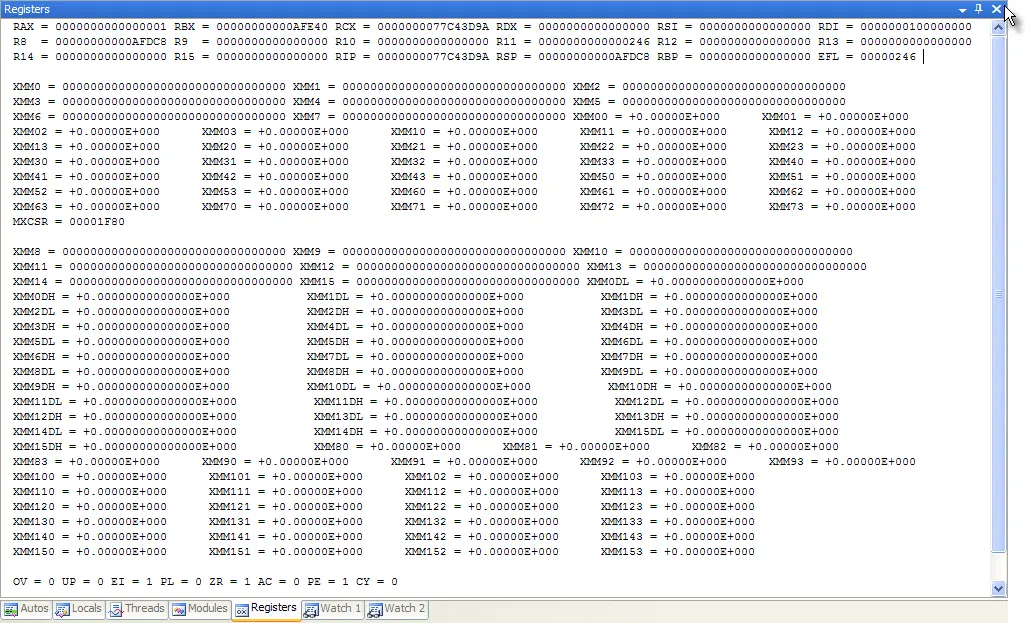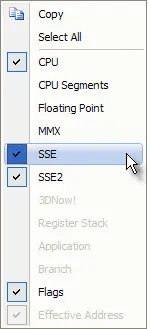64 bit porting gotcha #2! x64 Register preservation
In a previous article on x64 development I mentioned the problem of aligning the callstack on 16 byte boundaries and what happens if you do not do this.
Why 16 bytes?
At the time it seemed odd to me that the stack had to be 16 byte aligned. Why? All the parameters are 8 bytes (64 bits) wide and the first four are passed in registers. Everything else spills onto the stack and anything larger is passed as a reference. Floating point values are passed in dedicated floating point registers.
And there lies the key. That last sentence. The floating point registers.
Floating point on x64 is not done using the floating point coprocessor instructions. Instead the SSE instruction sets (and its extensions) are used.
If everything floats, whats the point?
If you are just hooking x64 functions and possibly collecting callstack you may never know need to know about floating point register preservation. We managed to get all four of our C++ tools (coverage, memory, profiler and deadlock detector) functional without knowing. Why would we need to know? Floating point preservation was never important for x86 because we could never damage the floating point without trying to do so.
But when we got into the details of the last bugs that were killing us we noticed seemingly random crashes. Closer investigation showed that calls to Win32 API functions had a tendency to wipe out the floating point registers. And that is when we got interested in what happens if we preserved the x64 floating point registers.
How to view the registers?

At first glance this wasn’t obvious to me.  The Registers window in Visual Studio just shows the registers from RAX through R15 etc. However if you right click this window there is a helpful context menu that allows you to choose just how much information you display in this window.
The Registers window in Visual Studio just shows the registers from RAX through R15 etc. However if you right click this window there is a helpful context menu that allows you to choose just how much information you display in this window.
Once you have the registers in view things get a lot easier inside the debugger. You can step through your code ensuring that nothing is getting trampled on until Viola! the floating point registers get totally hosed. A bit more investigation and you realise that seemingly innocent call you had in your code contains a call to a Win32 function (for example VirtualProtect) and that that function is responsible for the register death.
OK, so how do we preserve registers on x64? Its nothing like on x86.
x64 floating point preservation
The x64 designers in their infinite wisdom took away two very useful instructions (pushad and popad). As a result x64 hook writers now have to push lots of registers and pop lots of registers at the start and end of each hook. You can even see this in parts of the Windows operating system DLLs. So much simpler just to push everything and pop everything.
However what the Lord taketh away he can give back. And the x64 designers did that by providing two dedicated instructions for saving and restoring floating point. fxsave and fxrstor. These instructions take one operand each. The operand must point to a 512 byte chunk of memory which is 16 byte aligned.
A common usage would be as shown below although you can use any register as the destination location. It just so happens that the stack pointer (rsp) is the most common usage.
sub rsp, 200h; fxsave [rsp]; .. do your task that damages the floating point registers fxrstor [rsp;] add rsp, 200h;
When you see the above usage you can see why there is the requirement for the stack to be 16 byte aligned. Why 16 bytes? I suspect it is because it is the start of a cache line and that makes executing the instruction *SO* much quicker.
Conclusion
So now you know why the x64 callstack is 16 byte aligned. Its all to do with ensuring your code executes as fast as possible, especially when executing a memory intensive register copy when saving and restoring the x64 floating point registers. I’ve also shown you how to preserve and restore the floating point registers.